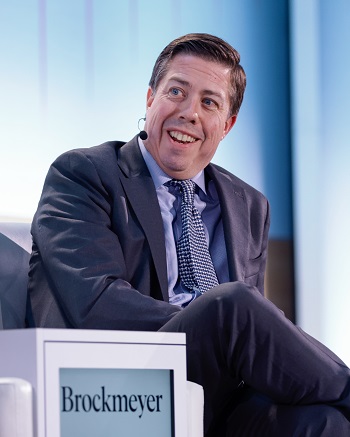
Gas strategies panelists Matthew Palmer, S&P Global Commodity Insights; Martin Hupka, Sempra Infrastructure; Corey Grindal, Cheniere Energy; Cynthia Hansen, Enbridge Inc.; and Rich Brockmeyer, Gunvor Group discuss natural gas storage at CERAWeek by S&P Global. (Source: Hart Energy)
The U.S. needs more gas storage capacity to help tame wild price changes in a market that exceeds 100 Bcf/d, LNG export plant operators, a gas distributor and a trader said on March 20 at CERAWeek by S&P Global.
“Obviously, we had COVID happen and that turned things upside down, followed by the Russian conflict. But right now, what we're seeing is the lack of enough storage capacity” in the U.S., Rich Brockmeyer, head of North American natural gas and power for international trader Gunvor Group.
“In the last eight years, [the U.S. has] gone from a 60 Bcf/d market to a 100 Bcf/d market. We haven't grown our storage capacity at all,” Brockmeyer said.
“So things will continue to be volatile until we build more storage capacity.”
Current U.S. working gas in storage is more than 4 Tcf and hasn’t meaningfully grown during this century, according to the Energy Information Administration.
But industrial and powergen demand for U.S. natural gas has grown. And LNG export capacity currently totals more than 14 Bcf/d, according to industry data.
Also, the U.S. exports up to 7 Bcf/d to Mexico via pipe—another advent of the past decade.

“We have so much more going on now,” Brockmeyer said.
Sudden, reduced gas use comes when an LNG plant goes down. The current U.S. storage overhang includes more than 400 Bcf that wasn’t exported when Freeport LNG was turned off for more than seven months in 2022 into 2023 after an accident.
Altogether, 2024 gas dynamics are “going to cause continued volatility in the spot markets until we can handle that [supply and demand growth],” Brockmeyer said.
The numbers are only going to get bigger. “We also have a very old pipeline infrastructure network in this country,” so disruption can come from maintenance events.
“I would expect we'll have volatility for years to come.”
And ‘it’s expensive’
Cynthia Hansen, president of Enbridge Inc.’s gas transmission and midstream group, agreed that “storage growth has not kept pace with the growth in [gas] production.”
In 2010, the U.S. had 20% capacity in storage compared with production.
“That dropped by 2022 to about 13%. So you have all that volatility.”
Enbridge has more than 600 Bcf of storage in the U.S. and Canada. Last year, it bought the Aitken Creek facility in British Columbia for CA$400 million, picking up 77 Bcf of capacity.
Also, it bought the Tres Palacios caverns in Texas for US$335, picking up 35 Bcf as well as a fourth-cavern expansion that will add 6.5 Bcf.
Recently, clients have been paying higher prices for parking their gas — as much as 200%, Hansen said. “And people are turning out for longer [leases].
“So there's obviously the demand there. It's something that we're going to see continue to grow.”
But new storage-field capacity growth is “like anything else: It's expensive … if you're not just doing expansions on brownfield [facilities].”
As for creating organic additions, greenfield projects take a long time.
“If you're looking at starting a location—and it's not everywhere that you can actually develop storage; you have to have great formations available—that timeline from doing the work to confirm the space is available to meeting with your customers and doing permitting, that's at least a three- to four-year minimum process,” Hansen said.
“And then you have the actual build-out after that.
“So it's a long lead time. It's not something that—for significant capacity—you can build out very quickly.”
LNG suppliers weigh in
Martin Hupka, president of LNG and net zero for Sempra Infrastructure, noted that storage is essential in LNG operations. Sempra operates the 570 Bcf/year (an average 1.6 Bcf/d) Cameron LNG plant in southwestern Louisiana and is currently building plants on the Texas and western Mexico coasts.
The storage accessory “is independent to make sure that we actually do have the storage that can ensure that the plant can [operate],” Hupka said.
“As more LNG comes on, the storage question is going to become more and more significant because those plants are going to require that, if they're not building their own.”
Corey Grindal, COO for Cheniere Energy, concurred that owning gas in storage is essential in operations.
Cheniere is the largest U.S. LNG exporter, handling 2.2 Tcf/year (an average 6 Bcf/d) of capacity on the Louisiana and Texas coasts.
“So we have quite a bit of storage, right? … If something happens to one of our trains, which at times it does, that's [gas] that we put back on the market,” Grindal said.
“When we buy gas from producers, we don't sell it back to them. We either get rid of it in the market or we use our storage. So we own quite a bit of storage.
“We've owned it for a long time and we will continue to, especially as our business continues to grow.”
Recommended Reading
Plug Power CEO Sees Hydrogen as Part of US Energy Dominance
2025-01-29 - Plug Power CEO Andy Marsh says the U.S., with renewable energy resources, should be the world’s leading exporter of hydrogen as it competes globally, including with China.
Energy Transition in Motion (Week of Jan. 17, 2025)
2025-01-17 - Here is a look at some of this week’s renewable energy news, including more than $8 billion more in loans closed by the Department of Energy’s Loan Programs Office.
PE Firm Hy24 Commits $50MM to StormFisher Hydrogen
2025-02-11 - The funding, made via Hy24’s Clean Hydrogen Infrastructure Fund, will go toward StormFisher Hydrogen’s efforts to produce clean fuel in North America.
API’s Multi-Pronged Approach to Lower Carbon Operations
2025-01-28 - API has published nearly 100 standards addressing environmental performance and emissions reduction, which are constantly reviewed to support low carbon operations without compromising U.S. energy security.
Powerhouse: Enbridge Boosting Renewables, NatGas to Meet Surging Demand
2024-12-18 - As the need for clean and lower-carbon power grows, Enbridge is among the companies taking an all-of-the-above approach.
Comments
Add new comment
This conversation is moderated according to Hart Energy community rules. Please read the rules before joining the discussion. If you’re experiencing any technical problems, please contact our customer care team.






